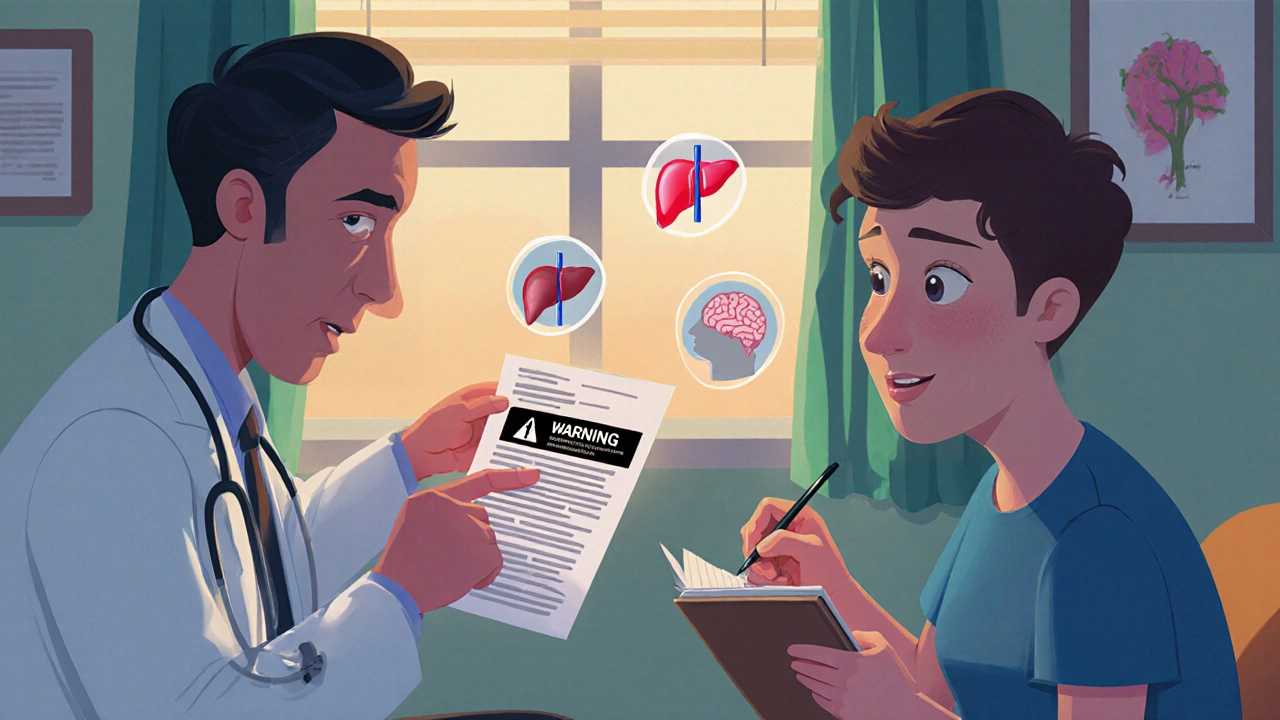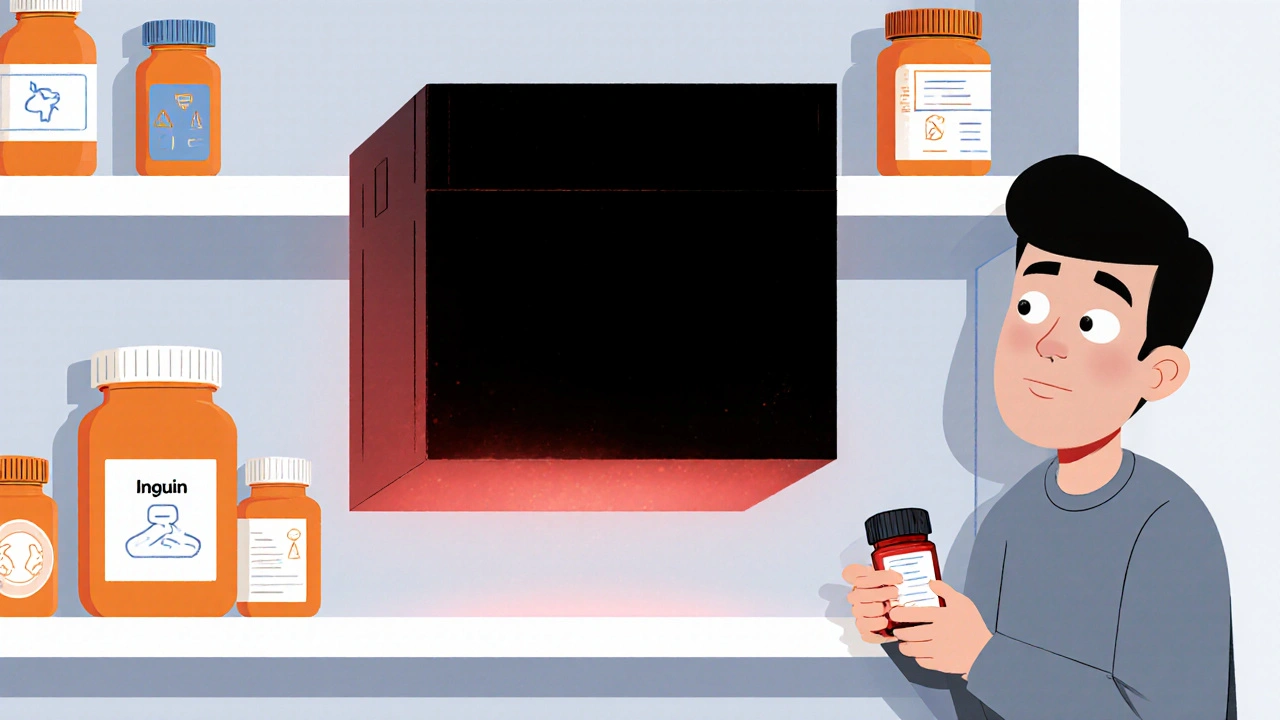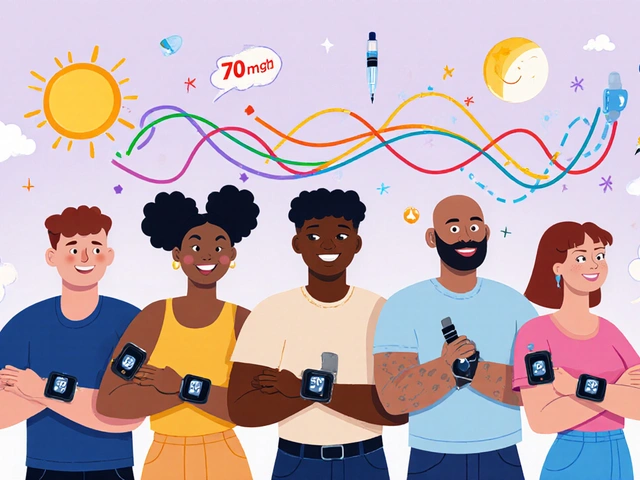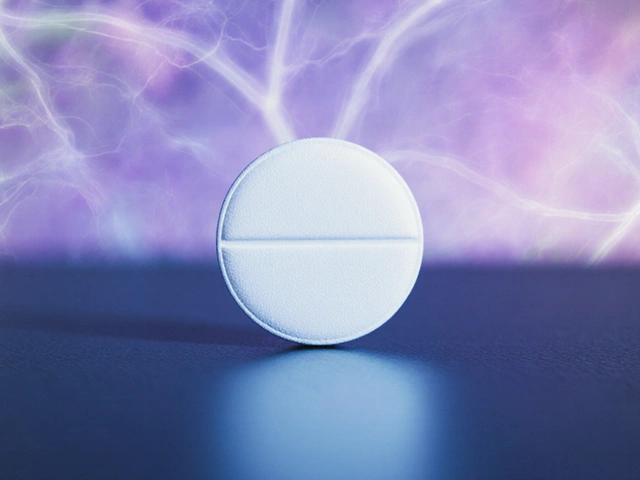Black Box Warning Checker
Check Your Medication Safety
Enter a prescription medication name to see if it has a FDA black box warning and what you need to know about potential risks.
Results
Enter a medication name to check for black box warnings
When you pick up a prescription, you might not notice it at first - but if you flip open the medication insert, there it is: a thick black border around a paragraph that stops you in your tracks. It says something like, "May cause severe liver damage" or "Increased risk of death in elderly patients with dementia." This is a black box warning - the strongest safety alert the U.S. Food and Drug Administration (FDA) can require on a prescription drug. It’s not a suggestion. It’s a red flag, printed in bold, with a border so you can’t miss it.
What Exactly Is a Black Box Warning?
A black box warning, officially called a boxed warning, is the FDA’s highest-level safety alert for prescription medications. It’s not used lightly. The agency only adds one when there’s clear evidence that a drug can cause serious, life-threatening, or permanently disabling side effects. These aren’t mild nausea or drowsiness - these are risks like heart failure, suicidal thoughts, liver failure, or sudden death.
As of 2023, more than 400 prescription drugs in the U.S. carry this warning. That’s about 15% of all prescription medications on the market. Many of these drugs are essential - used to treat cancer, severe depression, epilepsy, or autoimmune diseases. The warning doesn’t mean the drug is unsafe. It means the risks are real, and they need to be carefully weighed against the benefits.
Why Do These Warnings Exist?
Drugs are tested in clinical trials before approval, but those trials involve thousands of people - not millions. Rare side effects, or ones that only show up after years of use, often don’t appear until the drug is widely used. That’s when the FDA’s post-market surveillance kicks in. Doctors, pharmacists, and patients report problems through the FDA’s MedWatch program. In 2022 alone, over 1.2 million adverse event reports were filed.
When enough evidence piles up - like multiple cases of sudden cardiac death linked to a specific heart medication - the FDA contacts the drugmaker. They ask for proposed warning language. The company submits it. The FDA reviews and approves it. Then, the black box appears on the drug’s packaging and in the patient information leaflet.
There are four main reasons the FDA mandates a boxed warning:
- The drug has been linked to serious or fatal side effects where the risks may outweigh the benefits for some patients.
- The side effect can be avoided if the drug is used correctly - for example, only in certain doses or for specific conditions.
- The drug is approved for very limited use - like only for patients who haven’t responded to other treatments.
- The drug poses a higher risk to specific groups, such as children, pregnant women, or older adults.
Common Drugs With Black Box Warnings
You might be surprised to learn how many everyday prescriptions carry these warnings. Here are a few real examples:
- Antidepressants (like fluoxetine or sertraline): Increased risk of suicidal thoughts in children, teens, and young adults under 25 during the first few months of treatment.
- Insulin glargine (Lantus): Risk of severe hypoglycemia, especially in elderly patients or those with kidney problems.
- Fluoroquinolone antibiotics (like ciprofloxacin): Risk of tendon rupture, nerve damage, and aortic aneurysm - especially in older adults or those on steroids.
- Thiazolidinediones (like pioglitazone): Increased risk of heart failure and bladder cancer.
- Anti-seizure drugs (like valproate): Can cause severe liver damage or birth defects if taken during pregnancy.
Some of these drugs are lifesavers for the right person. But if you’re not the right person - or if you’re not monitored closely - the risks become dangerous.

Does a Black Box Warning Mean You Shouldn’t Take the Drug?
No. This is the biggest misconception. A black box warning doesn’t mean the drug is banned or useless. It means you and your doctor need to have a serious conversation about it.
Take antidepressants. For a teenager with severe depression, the risk of suicide from the illness is far higher than the risk from the medication. The warning exists so doctors don’t prescribe it blindly - they check for family history of suicide, monitor mood closely, and schedule follow-ups. The drug saves lives when used correctly.
Same with fluoroquinolones. They’re powerful antibiotics used for life-threatening infections like pneumonia or anthrax. But if you’re a 60-year-old on prednisone with a mild sinus infection? The risk of tendon rupture may not be worth it. There are safer alternatives.
As Dr. Meghan Lehmann, a pharmacist at Cleveland Clinic, puts it: "If a medication you’re taking carries a risk that warrants a black box warning, that doesn’t necessarily mean you shouldn’t take it. It means you need to understand why you’re taking it - and what you’re watching for."
What Should You Do If Your Medication Has a Black Box Warning?
Don’t panic. Don’t stop taking it on your own. Do this instead:
- Read the warning. Don’t just skim. Understand what the risk is, who it affects, and what symptoms to watch for.
- Ask your doctor: "Why is this drug right for me? What are the alternatives? What signs should I call you about?" Write down the answers.
- Ask your pharmacist: They can explain the warning in plain language and tell you what to avoid - like mixing with alcohol or other meds.
- Know your warning signs. For example, if you’re on an antidepressant, watch for new or worsening thoughts of self-harm. If you’re on a fluoroquinolone, watch for sudden pain or swelling in your tendons.
- Keep your appointments. Follow-up blood tests, EKGs, or check-ins aren’t optional. They’re part of the safety plan.
Studies show that 78% of patients want to know about a black box warning before starting a drug. But only 42% remember their doctor actually discussing it. Don’t assume they told you. Ask.
Why Don’t These Warnings Get Removed?
Once a black box warning is added, it rarely comes off. The FDA requires overwhelming evidence that the risk was overestimated - and that’s hard to prove. Since 2000, only 12 black box warnings have been completely removed.
Take rosiglitazone, a diabetes drug. After a boxed warning about heart risks, prescriptions dropped by 70%. But 3.8 million people still took it. Why? Because for some, it was the only thing that worked. The warning changed behavior, but didn’t eliminate use.
Removing a warning isn’t just about science - it’s about trust. If the FDA removed warnings too easily, people would stop believing them. That’s why the bar is so high.
What’s Changing in 2025?
The FDA is upgrading how it finds these risks. In 2025, a new AI-driven pharmacovigilance system will go live. It will scan millions of electronic health records and patient reports to spot safety signals 40% faster than before. That means warnings might appear sooner - not years after a drug hits the market, but within months.
They’re also testing "dynamic labeling." Instead of a static black box printed on paper, future labels could update in real time on digital apps or pharmacy portals. Imagine your medication app popping up a new warning the day a study comes out - no waiting for a new insert.
But the core idea stays the same: black box warnings exist to protect you. They’re not meant to scare you away from treatment. They’re meant to make sure you’re informed, monitored, and safe.
Final Thought: Knowledge Is Your Shield
Prescription drugs are powerful tools. Black box warnings are the safety guardrails. They don’t mean you can’t use the drug. They mean you need to use it wisely.
If you’re on a medication with this warning, you’re not alone. Millions are. But many don’t understand what it means. Don’t let confusion lead to fear. Ask questions. Read the fine print. Stay in touch with your care team. Your life may depend on it - not because the drug is dangerous, but because you’re paying attention.
Do black box warnings mean the drug is dangerous?
Not necessarily. A black box warning means the drug has serious, potentially life-threatening side effects - but those risks can be managed. Many drugs with these warnings are essential for treating serious conditions. The warning exists so doctors and patients make informed decisions, not to stop use entirely.
Can I stop taking my medication if it has a black box warning?
Never stop a prescription medication without talking to your doctor. Stopping suddenly can be dangerous - especially for drugs like antidepressants, seizure medications, or blood pressure pills. If you’re worried, schedule a visit to discuss alternatives, risks, and next steps.
Are black box warnings only in the U.S.?
The term "black box warning" is specific to the U.S. FDA. Other countries, like the UK, Canada, and Australia, use different systems - such as "contraindications," "precautions," or "serious adverse effects" in their product information. The level of risk may be similar, but the format and visibility differ.
Why didn’t my doctor tell me about the black box warning?
Studies show that doctors often assume patients will read the insert or that the warning is obvious. But many patients don’t read the paperwork, and doctors are pressed for time. If you didn’t hear about it, it’s not your fault - but you should ask. You have the right to know the risks before starting any medication.
Can a black box warning be removed?
Yes, but it’s extremely rare. The FDA requires strong, consistent evidence that the risk was overestimated or no longer applies. Since 2000, only 12 black box warnings have been removed. Most stay in place because the risk, while serious, is manageable with proper use.
Do over-the-counter drugs have black box warnings?
No. Black box warnings only apply to prescription medications. Over-the-counter drugs have warning labels too - like "May cause drowsiness" or "Do not use if you have liver disease" - but they don’t carry the same legal weight or visual prominence as FDA-mandated boxed warnings.
How common are black box warnings?
As of 2023, over 400 prescription drugs in the U.S. carry a black box warning. That’s roughly 15% of all prescription medications. They’re most common in drugs for cancer, mental health, heart disease, and autoimmune conditions - areas where the benefits are high but the risks are also significant.






Jessica Healey
November 18, 2025 AT 00:30So my doc just handed me a script for sertraline and said 'take it'... no mention of the black box. I read the insert later and nearly threw up. Guess I'm not the only one who gets ghosted on the risks.
Gordon Mcdonough
November 18, 2025 AT 12:44Ugh this is why I hate big pharma!! They sell death pills and then slap a black box on it like it's a coupon!! I mean come on!! We're just lab rats to these corporations!!
Levi Hobbs
November 19, 2025 AT 00:53Really appreciate this breakdown. I work in pharmacy, and I can't tell you how many patients just stare at the black box like it's a death sentence. The truth is, it's a conversation starter-not a stop sign. We always walk them through the real numbers: 'Yes, there's a risk, but your risk of untreated depression is 3x higher.' It's about context.
henry mariono
November 20, 2025 AT 11:03Thanks for writing this. I’ve been on fluoroquinolones twice. Both times, I had tendon pain but didn’t connect it. I wish I’d known more. Not blaming anyone-just saying, this info should be front and center, not buried in a 20-page PDF.
Sridhar Suvarna
November 21, 2025 AT 21:57As someone from India, I find this fascinating. Our regulators don't use black boxes, but the warnings are there in fine print. The difference is visibility. Here, the warning screams. In my country, it whispers. But the risk? It's the same. We need global standards, not just American branding.
Joseph Peel
November 22, 2025 AT 19:17Black box warnings are one of the few things the FDA gets right. They’re not perfect, but they’re transparent. Compare that to countries where adverse events are buried in bureaucratic reports. This isn’t fearmongering-it’s accountability. And accountability saves lives.
Kelsey Robertson
November 23, 2025 AT 01:50Oh please. The FDA adds these warnings like they’re decorating a Christmas tree. They’re terrified of lawsuits, not science. Did you know 90% of black box warnings are based on observational data? That’s correlation, not causation! They’re scaring people to cover their own backs. Wake up.
Joseph Townsend
November 24, 2025 AT 02:59Let me tell you something-black box warnings are the only thing keeping Big Pharma from turning us all into walking zombie pharmacists. I’ve seen people on antidepressants go from crying in the shower to holding their newborns. That black box? That’s not a threat-it’s a lifeline. It’s the difference between ‘you’re on your own’ and ‘we see you, we’re watching.’
Bill Machi
November 24, 2025 AT 08:03This is a classic example of government overreach. The FDA doesn't know my body better than I do. If I want to take a drug with a black box, that's my right. Why should a bureaucrat in D.C. decide what I can swallow? Let people choose. Stop infantilizing adults.
Elia DOnald Maluleke
November 24, 2025 AT 21:42In the grand tapestry of human health, the black box is not a condemnation-it is a mirror. It reflects the fragility of our biological systems and the hubris of our interventions. To fear the warning is to misunderstand the medicine. The true danger lies not in the box, but in the silence that follows its appearance.
satya pradeep
November 26, 2025 AT 07:12My uncle took pioglitazone for 8 years. No heart failure. No cancer. Just good sugar control. But his doctor never mentioned the black box. He found out from a friend. That’s messed up. Docs need to stop assuming we read the inserts. Just say it out loud. We’re not dumb. We just don’t know what to ask.